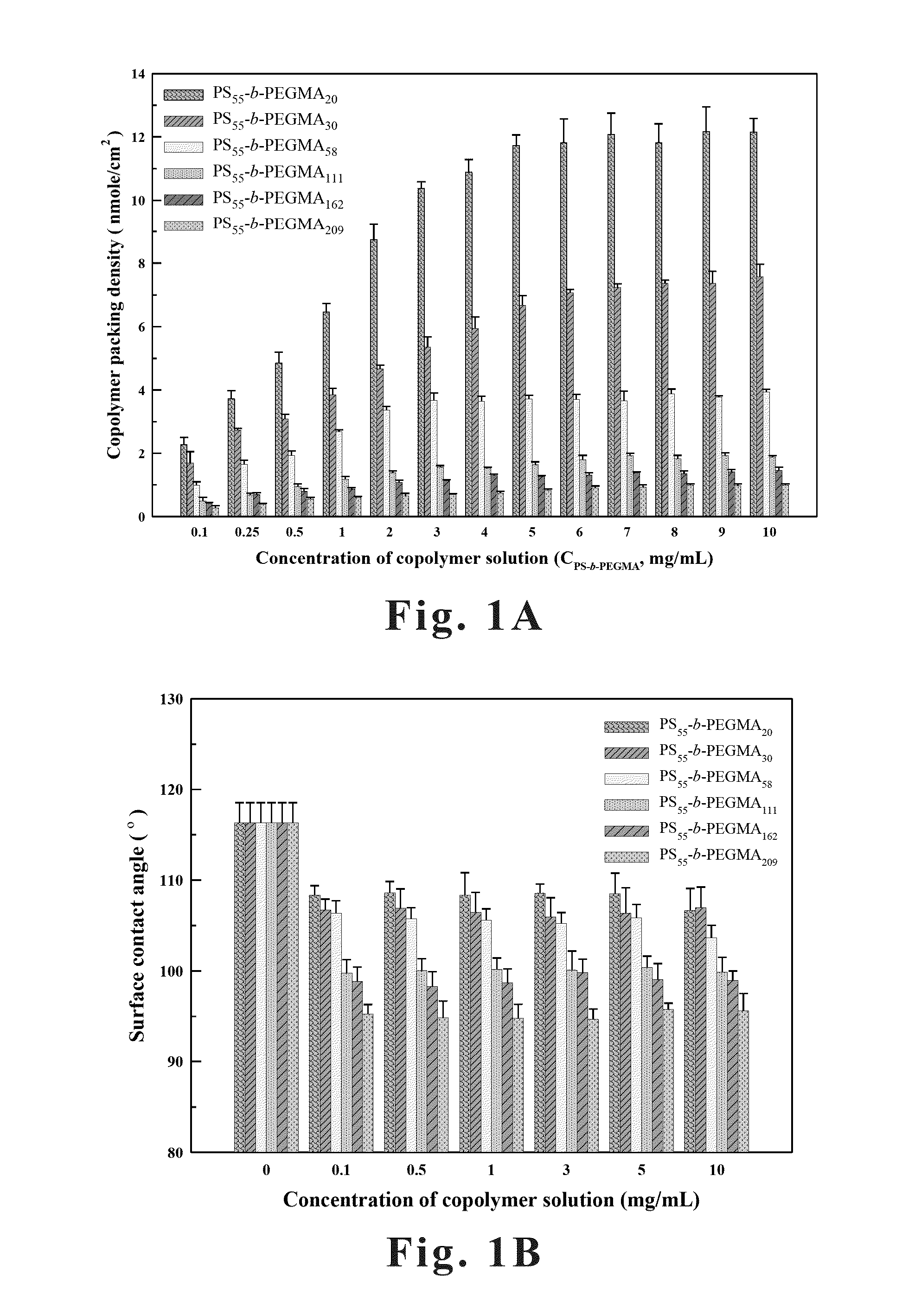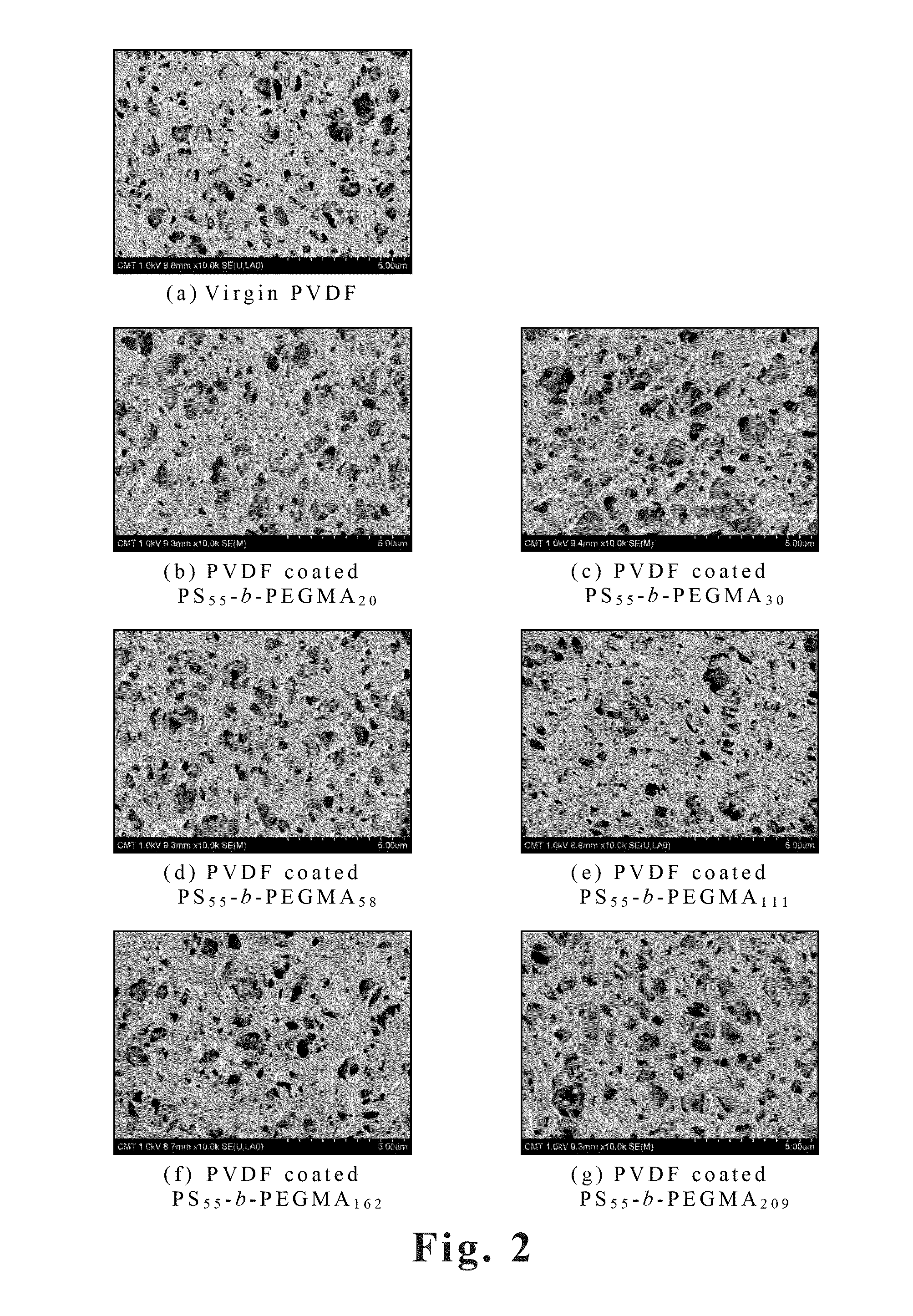Anti-biofouling Membrane for Water-Treatment
a technology of anti-biofouling membrane and water treatment, which is applied in the direction of membranes, filtration separation, separation processes, etc., can solve the problems of changing the configuration of the membrane, the inability to employ the suitable membrane as filtering material in the filtration process of water treatment, and the hot issue of water treatment cost reduction by employing membrane filtration. , to achieve the effect of low manufacturing cost, high stability and easy manufacturing process
- Summary
- Abstract
- Description
- Claims
- Application Information
AI Technical Summary
Benefits of technology
Problems solved by technology
Method used
Image
Examples
example 1
Synthesis of Anti-Biofouling Copolymer with Diblock Copolymer Form Through Atom Transfer Radical Polymerization (ATRP)
[0071]Firstly, styrene is polymerized by ATRP with methyl-2-bromopropionat (MBrP; from Aldrich, purity 98%) as radical initiator, and CuBr (from Aldrich, purity 99.99%) and 2,2′-bipyridyl (BPY; from Acros, purity 99%) as catalyst to obtain polystyrene (PS). While fixing the molar concentration of styrene at 0.39 mol, the average molecular weight of the obtained polystyrene can be controlled by the amount of radical initiator and catalyst. The reacting temperature during the mentioned polymerization is about 120° C., and the reacting time of the mentioned polymerization is 8 hours. After 8 hours, the mentioned polymerization is quenched by ice-bathed. The mentioned polymerization can be illustrated as the following scheme.
[0072]Subsequently, the obtained PS is polymerized with PEGMA in the second step. While fixing the molar concentration of PEGMA at 4.21 mmol, the ra...
example 2
Synthesis of Anti-Biofouling Copolymer with Random Copolymer Form Through Thermal-Induced Free-Radical Polymerization (TFRP)
[0074]Styrene is polymerized with PEGMA in the condition with 2,2′-azobisisobutyronitrile (AIBN; from SHOWA) as radical initiator and toluene (from Macron Fine Chemical) as solvent. The reaction concentration of the above polymerization is 30 wt %. The reacting temperature of the above polymerization is about 80° C., and the reacting time of the above polymerization is 24 hours. After 24 hours, the above polymerization is quenched by ice-bathed. The above polymerization can be illustrated as the following scheme.
[0075]The ratio of PS / PEGMA in the obtained anti-biofouling copolymer can be controlled by the amount of styrene and PEGMA in the above polymerization. And, the average molecular weight of the obtained anti-biofouling copolymer can be controlled by the amount of radical initiator (AIBN). After repeating the above-mentioned procedure with different PS / PE...
example 3
Synthesis of Anti-Biofouling Copolymer with Diblock Copolymer Form Through Reversible Addition-Fragmentation Chain Transfer Polymerization (RAFT)
[0076]Firstly, styrene monomer is polymerized by RAFT with 4,4′-Azobis(4-cyanovaleric acid)purum, ≧98.0% as radical initiator, and 5-cyano-5-[(phenylcarbonothioyl)thio]hexanoic acid as reagent to obtain polystyrene (PS). While fixing the molar concentration of styrene at 2.54 M, the average molecular weight of the obtained polystyrene can be controlled by the relative amount of radical initiator and catalyst. The reacting temperature during the mentioned polymerization is about 80° C., and the reacting time of the mentioned polymerization is 6 hours. After 6 hours, the mentioned polymerization is quenched by ice-bath. The mentioned polymerization can be illustrated as the following scheme.
[0077]Subsequently, the obtained PS is polymerized with PEGMA macromonomer in the second step. While fixing the concentration of PEGMA at 30 wt %, the rat...
PUM
| Property | Measurement | Unit |
|---|---|---|
| molecular weight | aaaaa | aaaaa |
| molecular weight | aaaaa | aaaaa |
| molecular weight | aaaaa | aaaaa |
Abstract
Description
Claims
Application Information
 Login to View More
Login to View More - R&D
- Intellectual Property
- Life Sciences
- Materials
- Tech Scout
- Unparalleled Data Quality
- Higher Quality Content
- 60% Fewer Hallucinations
Browse by: Latest US Patents, China's latest patents, Technical Efficacy Thesaurus, Application Domain, Technology Topic, Popular Technical Reports.
© 2025 PatSnap. All rights reserved.Legal|Privacy policy|Modern Slavery Act Transparency Statement|Sitemap|About US| Contact US: help@patsnap.com



